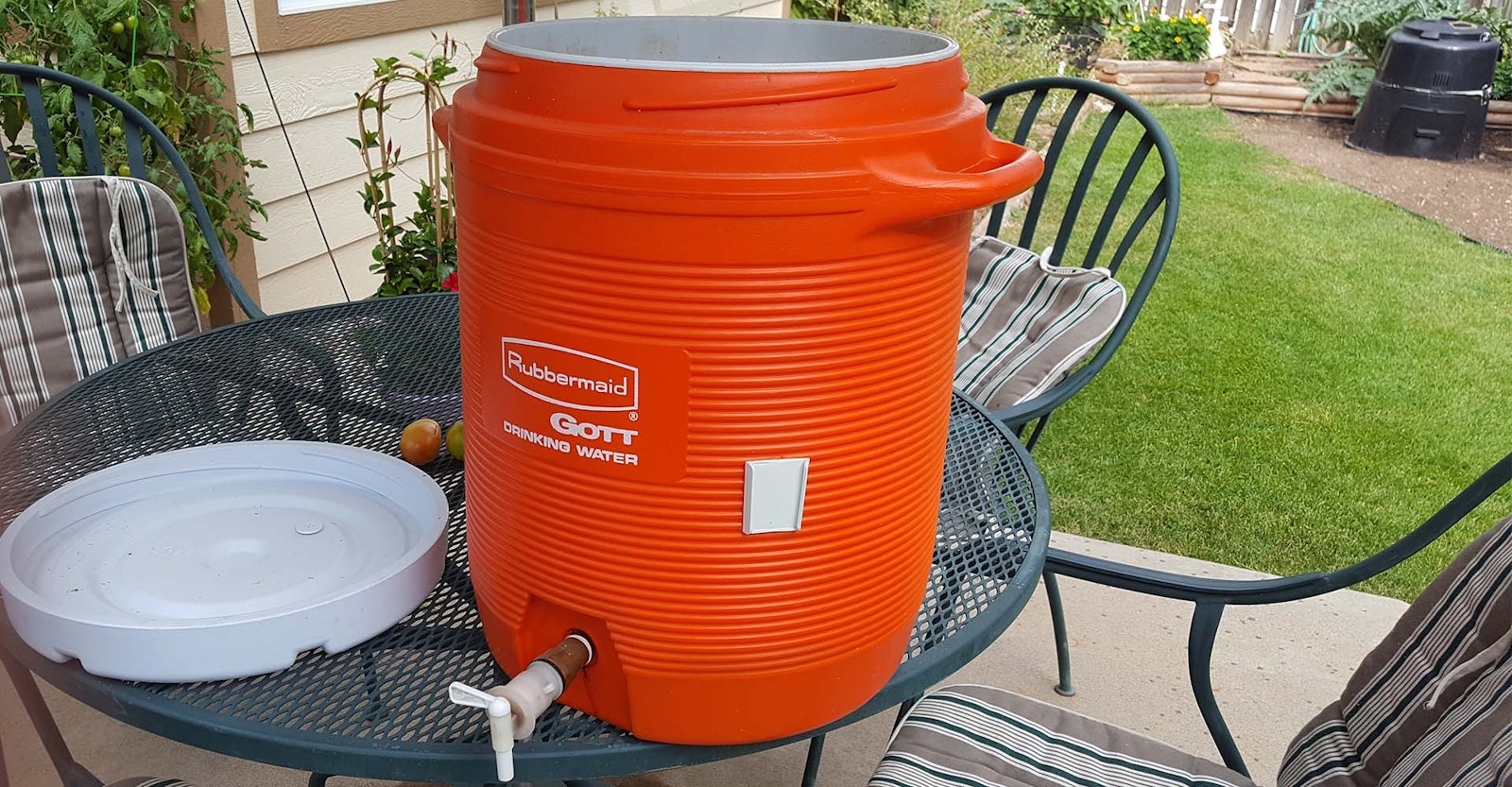Making the leap to all-grain brewing gives you finer control of your recipes and can also save you some money on ingredients, but it does require special equipment. You need a container to hold all the grain while the starches convert, and you need a way to rinse the sugars from the malt. It’s a simple problem with a multitude of solutions. Some people use a brew-in-a-bag setup, which is fairly simple, but it does require some muscle. The more traditional path is to use a mash tun with either a false bottom or some kind of manifold. Here, I’ll show you how to build a mash tun from a 10 gal (38 l) drink cooler (pictured above).
Parts List
- 10 gal (38 l) cylindrical drink cooler (Igloo or RubberMaid, for example)
- Tapping hardware
- Adapter: ½ in (13 mm) copper pipe to ¾ in (19 mm) FPT
- Bottling spigot
- Manifold parts
- Three ½ in (13 mm) copper tees
- Four ½ in (13 mm) copper end caps
- About 6 in (15 cm) of straight ½ in (13 mm) copper pipe
- About 6 ft (1.8 m) of ½ in (13 mm) copper tubing
Like any good DIY project, there are many paths to get to the completed project. This project in particular makes several design trade-offs. You could just use a stainless steel kettle as the vessel, but a cooler has built-in insulation, which will help to better maintain the mash temperature. Also notable is that a cylindrical drink cooler works better than a rectangular one because the geometry provides a good grain bed and efficient draining.
I’ve chosen to make the manifold from copper tubing. Other alternatives would be to make or buy a screened false bottom that fits the cooler (12 in/30 cm round for a 10 gal/38 l cooler) or to use a stainless steel braid as a filter.
Tools
- Pliers
- Plumbing torch
- Lead-free plumbing solder
- Flux
- Dremel tool with a cutting blade
- Pipe/tubing cutter
Build Steps
Three simple steps and you’re done—two easy steps and one that’s slightly more difficult.
Remove the Original Spigot
The original spigot on the cooler should be easy to remove: just loosen the nut that holds it in place. There should also be a rubber grommet on the spigot shaft. Be sure to set that aside, because we’ll reuse it.
Install the Tap
Screw the bottling spigot onto the copper adapter. Then, slide the copper adapter through the spigot hole from the outside. This should be a reasonably tight fit. Slip the rubber grommet onto the shaft of the adapter and push it through the wall of the cooler. I’ve seen other designs that bolt the tap hardware in place, but in my experience, the grommet alone forms a sufficient seal. The images below show the interior and exterior views of the tap.


Build the Manifold
Building the manifold is the most difficult part of the build. In this design, the manifold is made from three concentric rings of copper tubing that mount onto a drain shaft, pictured below.

The first step is to form the three rings. Shape the largest ring first, sizing it to be just smaller than the inside diameter of the cooler. Make the second ring a little bit smaller, about 8 in (20 cm) in diameter, and the center ring about 4 in (10 cm) in diameter. Be careful while bending the tubing—it’s easy to kink it if you go too fast. Once you have your rings, solder an end cap onto one side of each ring.
Next, we’ll construct the drain shaft from three copper tee segments joined by short sections of copper pipe:
- Start with a 3 in (7.6 cm) section of pipe as the base of the shaft.
- Solder on one of the tees, with the tee facing to the side, using lead-free plumbing solder.
- Solder a short 1–2 in (25–51 mm) piece of pipe as a connector for the next tee. This should be just long enough to connect the two tees.
- Solder another tee, with the tee facing in the opposite direction from the first tee.
- Solder another short piece of pipe and then the third tee, facing in the same direction as the first one.
- Finally, solder another short piece of pipe and then an end cap onto the shaft.
Notice that the tees are offset from one another so the rings will alternate directions while the drain shaft lays flat.

Check the fit before proceeding:
- Slip the base of the shaft into the copper adapter.
- Slip the rings onto the copper tees and make sure that everything can lie flat on the bottom of the cooler.
- You may need to shorten the base of the drain shaft and/or reshape your rings.
Once everything fits, you’re ready to cut the drain slots into the copper rings. A hacksaw will work, but a Dremel with a cutting blade is much quicker and easier. Before you start, remember that the rings branch off in alternating directions. Make sure you’re cutting the bottom side of the ring. Cut the slots about one-third to one-half of the way through the ring tubing, as pictured below.

Note that drain shaft components and the end caps are soldered but the rings are not. Similarly, the manifold slides easily into place as well. This makes it easier to dismantle for cleaning and storage.

